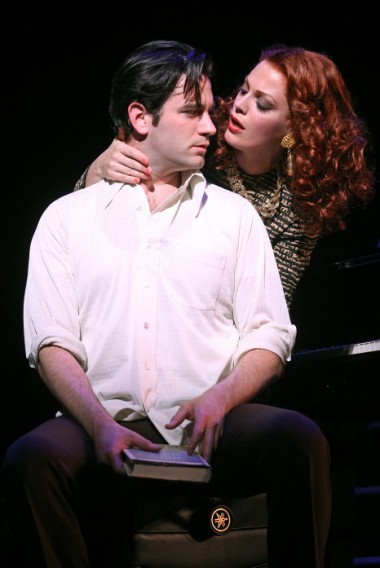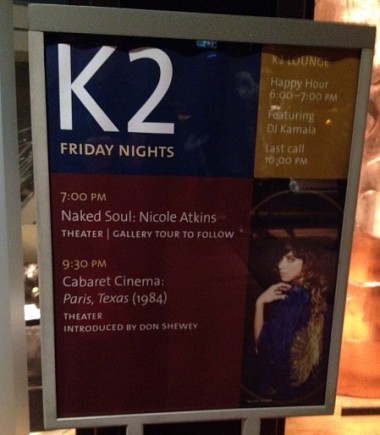Busy fun culture week.
SUNDAY: I got to see the penultimate performance at the Encores! series of Merrily We Roll Along at City Center. It’s always been one of my favorite Sondheim musicals, if not my very favorite. This is the adaptation of a Kaufman and Hart show-biz drama that moves backwards in time, starting from the present when the central character, Frank Shepard, is a super-successful Broadway composer who’s sold out to Hollywood and then moving back through the pivotal experiences and relationships that made him who he is. I’m not even that much of a musical theater geek, but I saw the short-lived original Hal Prince production in 1981 and loved the show and the music and the emotional sweep of the show, despite the ridiculous costumes and production design. As with many Sondheim shows, it was impeccably recorded (by Thomas Z. Shepard for RCA Records), and it’s through the original cast recording that many, many people grew to love this show. It’s great theater for the ear and a fantastic score. To my taste, there’s never been a better Charley Kringas than Lonny Price (especially his version of “Franklin Shepard, Inc.”), and I’m very partial to Ann Morrison’s performance as Mary (for me, she kinda owns “Like It Was” and “Now You Know”) — plus Jason Alexander’s finest moment, as Joe.

I’d go see any production of Merrily that comes down the pike. I did see the pretty mediocre York Theater production (directed by Susan H. Schulman, starring Malcolm Gets) but the gold standard has always been James Lapine’s staging at the La Jolla Playhouse in 1985 with John Rubinstein, Chip Zien, and Heather McRae. Encores! tapped Lapine to mount the concert version at City Center, and he did a great job — not quite obliterating my fondness for the La Jolla version, partly because the full staging made that production more forceful. But it was pretty damn good at City Center. The show is such a moving, intense, bittersweet, super-ambivalent slice of adult wisdom — rueful in suggesting that we inevitably lose significant shards of our integrity as we age, upsetting in its honesty about the light and shadow aspects of friendship, and yet inspiring in the way it captures youthful idealism. It’s a deep show, and it’s hard not to be moved to tears by the kids at the end claiming “It’s our time!” At City Center, I couldn’t help thinking that today’s versions of the twentysomething Frank and Charlie and Mary would be Occupying Wall Street.

Lovely performances by Celia Keenan-Bolger and Lin-Manuel Miranda as Mary and Charley, but for me two other performances by non-hyphenated actors were revelations: Colin Donnell as Frank and Elizabeth Stanley as Gussie (above). Donnell is so good I may have to go see Anything Goes, and Stanley is definitely star material — she got to do the new number that Sondheim cooked up for this production, the act-two opener that gives us an excerpt of Frank and Charlie’s hit show, Musical Husbands.
MONDAY: I’m a big fan of Edmund White and will read anything he writes. I enjoyed Jack Holmes and His Friend a lot while reading it, so I was surprised to feel a little letdown by the very ending. It seemed weightless and inconsequential. But the form of the novel, which centers on a gay man who is in love with a straight friend, is somewhat experimental, so it works on you after the fact. The four sections alternate between third-person omniscient narrative and first-person narrative by Will, the straight guy — I think this is White’s first attempt to write in the voice of a heterosexual male, and at times it seems strained and somewhat cliched, though I can’t be sure if that’s intentional on White’s part. Ultimately, it’s an intriguingly detailed, characteristically sexually explicit take on how the advent of AIDS affected the kind of straight people who were just starting to explore the sexual freedom gay men claimed for themselves in the 1960s and ’70s.

I was alarmed to read an interview with White in the Gay and Lesbian Review, where he mentioned that he recently had a stroke. Nevertheless, his writing here is strong, and many passages dazzled me and made me laugh, such as this description of two women working as personnel directors for a literary magazine: “They’d been sitting in the same small office, with its dust and snake plants, for thirty years. Every surface was covered with files. They wore hats perched incongruously above their wide, bloated faces, like flowers taped to livestock.” And: “He’d never thought of his grandmother as a woman before — more as a matron with a firm, molded mono-bosom and a diamond brooch and a low, Southern twang than as a woman with soft white breasts like warm dachshunds in constant motion, dogs with huge brown noses.”
TUESDAY: Anthology Film Archives in the East Village is running a fantastic and comprehensive film series devoted to the Wooster Group, including a 10-program retrospective of film and video documentation of their glorious stage productions. When I ran into Cynthia Hedstrom at St. Ann’s Warehouse last week, she urged me to show up for the video reconstruction of Rumstick Road, and I’m so glad I did. The middle piece of the group’s Three Places in Rhode Island, Rumstick Road was really the work that launched Spalding Gray’s career as a solo performer and storyteller. At the center of the piece is Spalding telling the story of his mother’s suicide, using tape-recorded recollections by his father, his grandmother, and a psychiatrist who’d treated his mother. And Elizabeth LeCompte was just beginning to hone the tools that have made her the legendary genius director she is: having the actors lip-synch the recordings and developing with her three outrageously talented and fearless performers (Gray, Ron Vawter, and Libby Howe) and kindred-spirit techies (Jim Clayburgh and Bruce Porter) a variety of physical actions and visual images to complement the verbal material.

The piece was first shown in 1977 and performed periodically through 1980 (I saw it, weirdly enough, when it had a brief uptown run at the American Place Theater), back when the Wooster Group was called The Performance Group and were virtually unknown and barely scraping by. Various bits and pieces of Rumstick Road were captured on video, film, and audiotape but never a complete documented performance. Recently, LeCompte and filmmaker Ken Kobland sat down with the hodgepodge of chunks and ingeniously reconstructed the entire performance. It’s very rough and sometimes crude, which is of course perfect for LeCompte’s aesthetic. And looking back at the piece now, it’s astonishing to see how original and strong a work of art it is. The reconstruction includes a number of close-up shots that enhance the viewing experience (I hadn’t retained a clear memory of the crazy moment when Ron Vawter, wearing a latex old-lady mask, examined Spalding’s mouth at length, pulling out and stroking his tongue with his fingers). It was thrilling to re-experience the show, but also sad recalling those wonderful young actors lost to AIDS (Vawter), suicide (Gray), and mental illness (Howe).
WEDNESDAY: Rehearsal with Gamelan Kusuma Laras. I’m excited that I’m slowly, slowly starting to learn how to play a new instrument, bonang panerus (below), with lots of help and coaching from more experienced players (thanks, Carla! thanks, Dylan! thanks, Oki!).

THURSDAY: I finally finished reading Electric Eden, British music critic Rob Young’s dense, ambitious, obsessive, and impressive history of a certain stripe of British pop-folk music. He originally set out to focus on a specific set of quirky, seminal bands and performers who bridged the gap between traditional English folk music, rock and roll, and post-Dylan singer-songwriters — the likes of Fairport Convention (whose members included Richard Thompson and the late Sandy Denny), the Incredible String Band, Pentangle, Steeleye Span, Donovan, and Nick Drake. But his research led him to deep thinking about the British history and culture and geography that music emerged from, and he also found himself tracking the artists forward through the tributaries of psychedelia, art-rock, glam-rock, punk, and other sound experiments. It’s one of the most impressive, intelligent books about pop music I’ve ever encountered, extremely well-written, scrupulously factual, and free of cheap, stupid generalizations.

I learned lots about music that was near and dear to me as a precocious teenage listener, and he writes about tons of artists I’ve never heard of before who sound fascinating (Mighty Baby? Comus?). His discography alone provides a graduate-level study guide to some beautiful and curious musical byroads. I never knew, for instance, that the Beatles created a 15-minute sound collage called “Carnival of Light” around the time of Sgt. Pepper! Here’s his succinct description of the tipping point, when the hippie-dippy pastoral rootsiness of acts like the Incredible String Band began to be eclipsed by the dark urban edginess of David Bowie: “If folk, folk-rock and its tributaries were, however subconsciously, believed to spring from collective, stable racial memory, glam tipped music into a wilderness of masks and mirrors, divided selves refracted through a succession of grotesque invented facades.”

FRIDAY: I was asked to give a nine-minute talk introducing the Wim Wenders/Sam Shepard film Paris, Texas at the Rubin Museum‘s Cabaret Cinema series, which prompted me to read this informative interview with Wenders and also gave me the delightful opportunity to watch the film again. I hadn’t seen it since it opened at the New York Film Festival in 1984. Man, Robby Muller’s cinematography is spectacular, starting from the opening shots of Harry Dean Stanton striding with absurd purposefulness through the lunar landscape of the Grand Canyon. And Ry Cooder’s music has never been more beautifully matached with a film. I will admit that I slipped out early, so as to avoid watching Nastassia Kinski, whose performance I recall as acutely embarrassing. The Rubin is a great museum, the people who work there are super-nice, the place was packed and buzzing on a Friday night, and I look forward to using my gift membership to view their always-engrossing exhibitions, starting with a show I know Andy will want to see: “Hero, Villain, Yeti: Tibet in Comics.”

February 27, 2012 at 9:24 pm
Re: Merrily. I saw the original in ’81 (preview) then the Encores! production. I’ve always loved the score, but I still find the form the narrative takes, traveling backwards in time, more frustrating than enlightening. Glad to know that’s not a problem for you. I agree with you that the score is among Sondheim’s best.
As for Colin Donnell, he’s definitely worth checking out in Anything Goes. (Why the resistance from you to this production anyway?) He’s cute and funny and romantic, plus he sings and dances with charm, so what’s not to like? I do recommend that you see it before March 11th, to catch Sutton Foster’s performance. I doubted she’d do justice to the part, but she made a true believer out of me. I went back a second, then a third time, to see if the magic would wear off. It didn’t. So go.